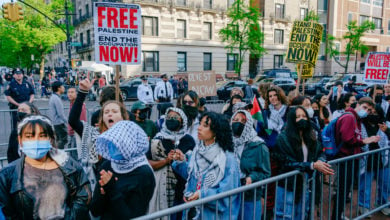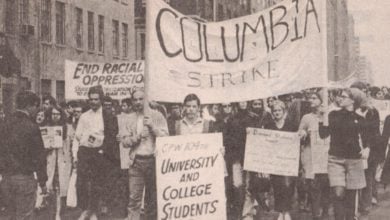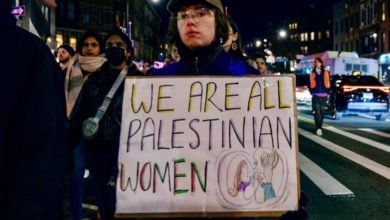Photo: The Scientists Against Genocide encampment at MIT. Credit: Liberation photo
Nishad Gothoskar is a PhD student at MIT.
As Gaza Solidarity Encampments sweep the country demanding divestment from Israel and corporations that profit from Israeli occupation, the student movement is drawing attention to their universities’ active roles in supporting war and genocide. In fact, academic institutions are hubs of fundamental research and development that are used in military technology and serve as pipelines into the military and defense industry by educating and training their future leaders.
The term “military-industrial complex” (MIC) often evokes images of powerful defense contractors partnering with the U.S. military to build fighter jets, missiles, and tanks. But this term often overlooks the crucial role of universities. But our understanding of the MIC is incomplete without recognizing that role academia plays in this ecosystem.
The promise of academia for many is in intellectual freedom and the independent pursuit of knowledge. And many young minds are drawn to academic institutions to take up scientific and technological endeavors to help build a brighter future for society. Whether it’s developing renewable energy to combat the climate crisis, pioneering breakthroughs in medicine to fight disease, or developing AI technologies that improve the lives of working people, many researchers are driven by a shared vision of progress.
But behind the idealistic facade is a stark reality. Today, academic institutions have become increasingly controlled by corporate and military interests. Instead of intellectual freedom, the research we pursue is defined by those that have the resources to fund it. And as a result, instead of the pure pursuit of knowledge for a brighter future, we do science and technology for war, imperialism, profit, and exploitation.
Academia’s entanglement in U.S. imperialism
The entanglement of academia with the MIC is deep and stretches back decades. But certain moments have shed light on this relationship.
In 1942, as the United States mobilized for World War II, it started the Manhattan Project. With millions of dollars of U.S. military money, the project enlisted top physicists, engineers, and mathematicians from institutions across the country and deployed them to develop a nuclear weapon. Despite numerous warnings from these same scientists about the effects of these weapons, as well as uncertainty around whether dropping the bombs was actually necessary to force a Japanese surrender, President Truman dropped two bombs on Hiroshima and Nagasaki killing over 200,000 Japanese civilians. The Manhattan Project serves as a sobering reminder of how academic research can be weaponized for imperialism with devastating consequences.
The legacy of the WWII era reverberated into the Cold War era, where the arms race and the space race against the Soviet Union were fueled by university research. Academic institutions became partners in the pursuit of military and technological supremacy. There was a dramatic expansion of government-funded science and technology research with billions of dollars of funding flowing into academic research through DARPA (the Defense Advanced Research Projects Agency), the Department of Defense, the Office of Naval Research, and the National Security Agency. Research agendas were shaped and manipulated by the demands of national security. And resources were diverted away from civilian-oriented research towards military objectives. The imperialist ruling class was strengthening its grip on academic research.
‘No war profiteers on campus!‘
But students saw the complicity of their universities clearly and rose up to fight back. By 1968, the United States was heavily involved in an escalating and increasingly gruesome war on the people of Vietnam. Students were at the forefront of the anti-war movement, which was drawing connections between these academic institutions and imperialism against a nearly 30-year long national liberation struggle.
Students on campuses around the country protested university research on chemical weapons like Agent Orange and napalm. They demanded, “No war profiteers on campus!” In May 1970, an estimated 4 million young people joined protests that shut down classes at 900 colleges, universities, and high schools around the country. These actions directly threatened the power of corporations, the MIC, the ruling class, perhaps even the capitalist state itself.
The ruling class responded with violent repression. On May 4, during a rally opposing expanding involvement of the Vietnam War into Cambodia at Kent State University, the Ohio National Guard was sent onto campus, firing on protesters and killing four students and wounding nine others. This tragedy came to be known as the Kent State massacre. The killings triggered outrage on campuses across the country, ultimately growing the strength of the student movement.
The echoes of these past struggles resonate into the present day, where a new generation of students have taken up the struggle against universities’ ties to war and the defense industry. Drawing inspiration from the movements against the Vietnam War and apartheid in South Africa, thousands of students across the country are demanding that their universities end their complicity with Israel’s genocide of the Palestinian people and divest from Israeli-linked corporations. Students have set up encampments on their campuses to make it clear to universities that they will not back down until their demands are met.
At MIT, student organizers have set up a Scientists Against Genocide encampment and are demanding that the university cut all research ties with the Israeli military.
Daniel Shen, a graduate worker and organizer with the encampment, explained, “At MIT, students have set up and maintained an encampment for almost two weeks to protest the school’s direct research ties with the Israeli military and complicity in the ongoing genocide.”
“There are projects funded by the Israeli Ministry of Defense to make autonomous drone swarms, for example, which have clear military applications to what’s happening in occupied Palestine,” Shen continued. “We need these funding ties and research collaborations to end. And the MIT community and broader Cambridge community have been continually showing up to the encampment in support of this demand.”
Across the country, students are making similar demands of their institutions to end their complicity in the genocide in Gaza.
Free Palestine, from the river to the sea
Meanwhile, university administrators, police, and politicians are working together to repress the movement — often violently, as police raids on UCLA, City College of New York, and Columbia encampments have shown. In spite of these attacks, the students remain steadfast in their commitment.
The student movement for Palestine is a testament to the power of collective action and the unwavering dedication to the Palestinian liberation struggle. Their courage and resilience is an inspiration to the broader movement. Ultimately, it is through the collective power of the international working class movement for Palestine, that is growing and rising by the day, that we will force an end the U.S.-Israeli genocide and free Palestine, from the river to the sea.






